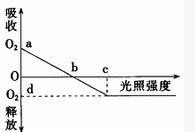问题
单项选择题
如图为植物光合作用强度随光照强度变化的坐标图,下列叙述中不正确的是()。

A.a点叶肉细胞产生ATP的细胞器只有线粒体
B.b点植物光合作用强度与细胞呼吸强度相等
C.当植物缺镁时,b点将向左移
D.己知某植物光合作用和细胞呼吸最适温度分别为25℃和30℃,如图表示该植物处于25℃环境中,则将温度提高到30℃时,a点上移,b点右移,d点上移
答案
参考答案:C
解析:a点只进行细胞呼吸,A正确。b点植物氧气释放量为0,即光合作用释放的氧气刚好被细胞呼吸利用,B正确。缺镁时,叶绿素合成下降,利用光能能力下降,植物需要较强光照才能达到与细胞呼吸速率相等的光合强度,b点右移,C错误。植物处于25℃环境中,则将温度提高到30℃时,光合强度下降,呼吸强度上升,故a点表示呼吸强度上移.b点表示净光合速率为0,即需要较强光照才能达到与呼吸速率相等的光合速率,右移:d点表示最大净光合速率,由于呼吸速率上升,故上移,D项正确。
